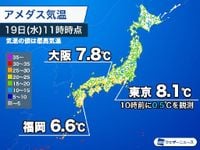On March 19, 2025, Tokyo experienced an unexpected cold snap as temperatures dipped dramatically, leading to snow accumulation during morning rush hour. The capital, known for its fluctuating weather this time of year, registered a temperature of only 0.7 degrees Celsius at 10 AM, with a notable 1 cm of snowfall reported.
The day began with a relatively warm 6.6 degrees Celsius at 5 AM, but by 8 AM, temperatures plummeted to 1.3 degrees, hitting a low of 0.5 degrees Celsius by 9:51 AM. As the morning wore on, sporadic snow began falling, causing disruption for commuters and prompting warnings of slips and falls due to icy conditions. By 11 AM, the temperature returned slightly to 2.2 degrees Celsius; however, the snow had turned to rain.
This sudden weather shift was attributed to a strong cold air mass hovering over Japan, which also brought frigid temperatures to western and eastern regions, where cities like Nagoya, Osaka, and Fukuoka reported daytime highs of only 9.4, 7.8, and 6.6 degrees Celsius respectively. The looming cold front had created conditions akin to what one might expect in the heart of winter.
The national weather service noted that the forecast initially called for rain in Tokyo, but unexpected high northerly winds combined with residual moisture from passing rain clouds led to snow instead. The rapid temperature drop created an ideal scenario for snow to form, especially given that at 6 AM, the city was still experiencing rain with 4.2 degrees Celsius recorded.
Reflecting on the morning's conditions, weather analyst Go Yazawa explained, "The temperature was expected to rise. However, the unexpectedly strong north wind caused it to drop instead, resulting in snow accumulation. This unseasonal weather caught many off guard, as typical March conditions involve warmer spells as spring approaches." His comments underscored the unpredictability of spring weather in the region.
Yazawa further indicated that there remains a possibility for snow to appear in early April, warning, “This winter-spring transitional period has been characterized by considerable fluctuations in temperature, making it likely that we could see cold air masses return intermittently.” He advised residents to keep their winter coats handy as this unusual cold could persist longer into the season than anticipated.
While the weather is predicted to improve somewhat by March 20, with expected temperatures climbing to around 12 degrees Celsius, the conditions for outdoor activities will still require vigilance against the cold. Following this brief winter resurgence, warmer weather is forecast for March 21 and beyond, where temperatures are expected to exceed 20 degrees, ushering in a more typical springtime feel.
Despite this temporary cold shock, authorities have issued warnings across various regions, anticipating frozen roads and possible disruptions. By midday, a “heavy snowfall warning” was in effect for areas west of Tokyo, specifically Moika Town and Hinohara Village. Officials have urged residents to exercise caution and avoid unnecessary travel during the hazardous conditions to prevent accidents.
In summary, the unexpected arrival of snow during the early morning hours of March 19 has reminded Tokyo residents of the unpredictable nature of spring weather. While relief is on the horizon with warmer temperatures projected for late March, the accompanying strong cold fronts highlight the need for preparedness and caution in the days ahead.
Tokyo's residents are encouraged to approach the coming days with layered clothing and winter attire until the warm weather establishes itself firmly. Snow may linger in their memories, but a shift towards brightened spring weather seems to be on the way, promising a thaw from this wintry interlude.



